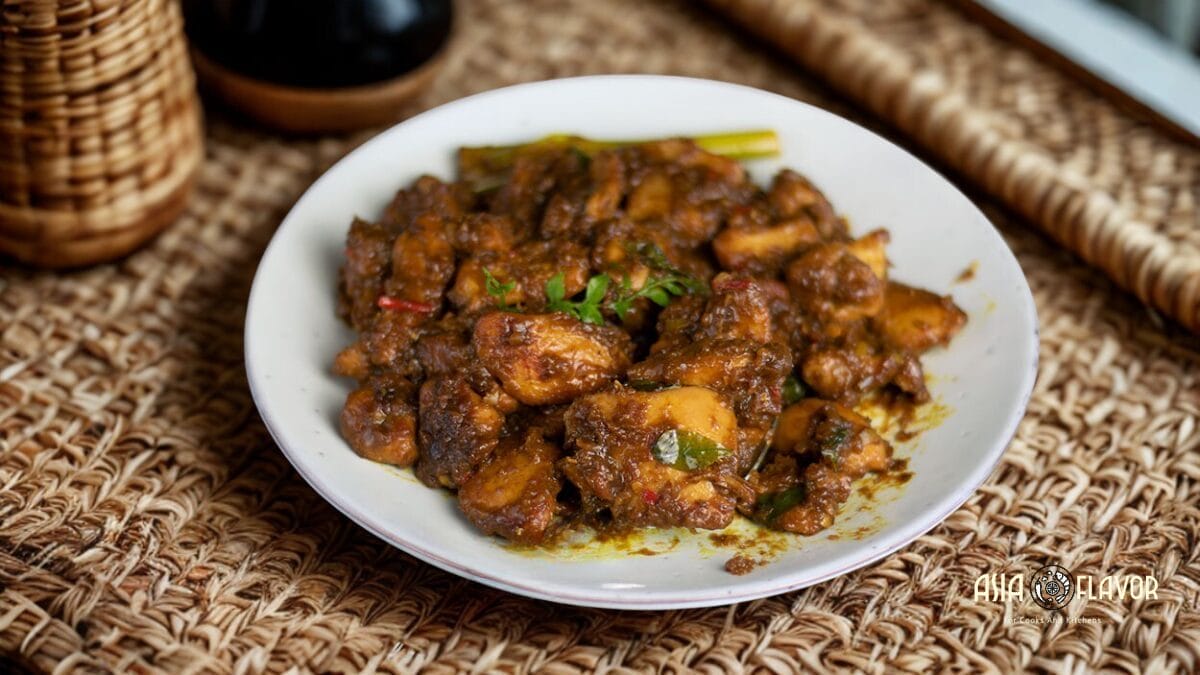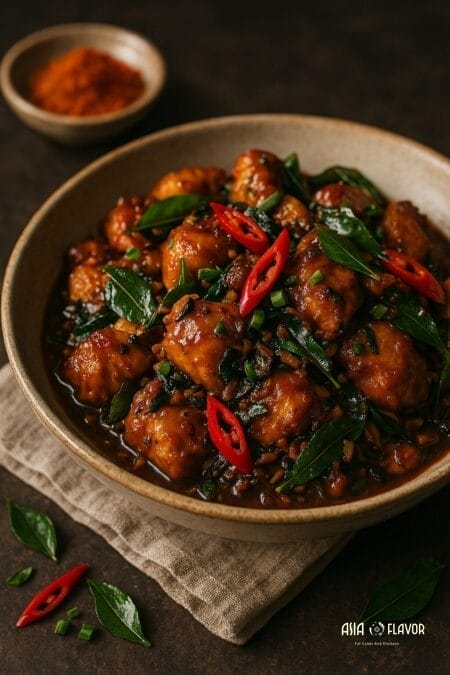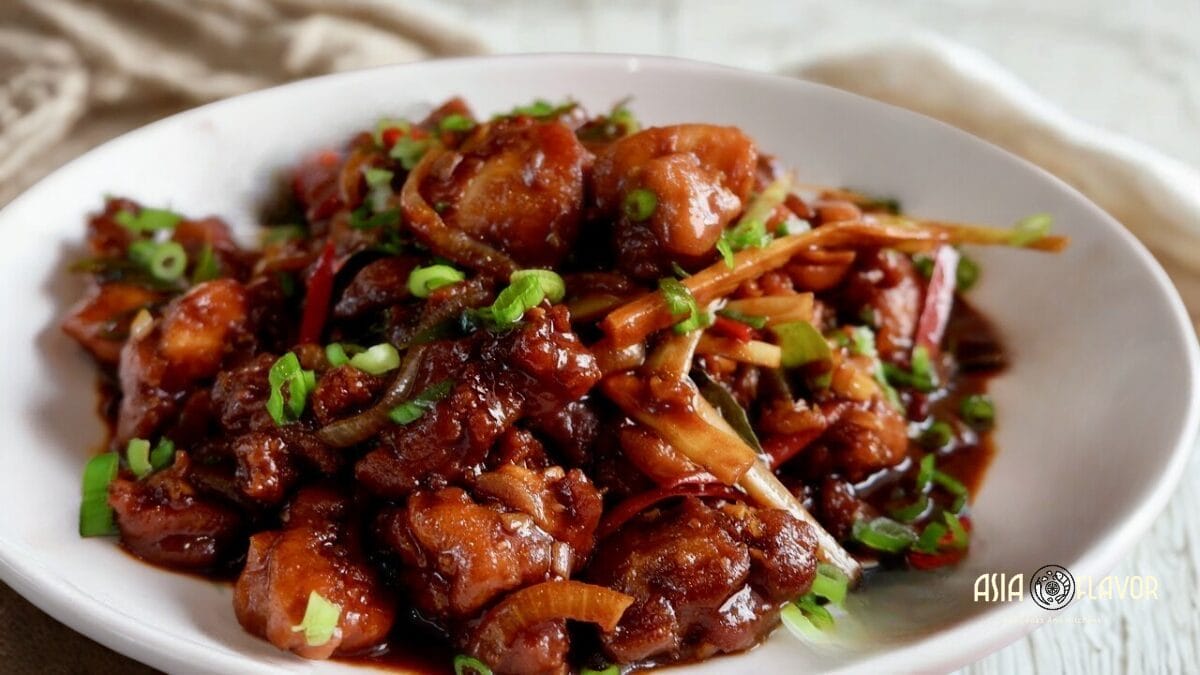Imagine a dish that captures the essence of a nation! This culinary fusion blends the flavors of three distinct ethnicities into a single, tantalizing experience. The Dish? Malaysian Kam Heong Chicken! Originating from Malaysia, this dish has evolved into a much loved staple for many, standing as a testament to the vibrant mix of cultures that influence Malaysia and its cuisine. From bustling street markets to high-end restaurants, Kam Heong Chicken has made its mark, but how exactly did this dish come to be, and what makes it so irresistible?
Behind the sizzle of Kam Heong Chicken lies a history as flavorful as the dish itself. With roots tracing back to Chinese, Indian, and Malay influences, it’s a culinary marvel that showcases the harmonious blend of various ethnic backgrounds. This post will guide you through the intriguing origins, regional twists, and indispensable ingredients that define Kam Heong Chicken. Whether you’re a seasoned foodie or an adventurous cook, uncovering the secrets behind this dish promises to be as delightful as tasting it.

Malaysian Influence: How Geography Shaped Kam Heong Chicken
Malaysia’s unique geography, straddling peninsular and island territories between the Indian and Pacific Oceans, has fostered a vibrant exchange of cultures and ingredients over centuries. Port cities like Malacca and Penang became melting pots where traders from China, India, and the Malay Archipelago converged—each bringing spices, cooking techniques, and culinary traditions. It’s in this crossroads of trade and migration that Kam Heong Chicken found fertile ground to evolve.
Coastal access meant an abundance of seafood and fresh produce, while inland plantations offered spices like turmeric, lemongrass, and chilies. This diverse terroir allowed local cooks to experiment, marrying local Malay flavors—galangal, belacan (fermented shrimp paste), and coconut milk—with imported Chinese soy sauces and Indian spice blends. Over time, these influences crystallized into what we know today as Kam Heong Chicken: a dish that embodies Malaysia’s geographical significance as a junction of flavors and cultures.
The Birth of Kam Heong Chicken: A Fusion of Culinary Cultures
The genesis of Kam Heong Chicken can be traced back to small roadside stalls and hawker centers, where inventive cooks combined leftover ingredients from various ethnic kitchens to minimize waste and maximize flavor. “Kam Heong,” which loosely translates to “golden fragrance,” originally referred to a sauce base used for stir-frying seafood, poultry, and vegetables.
Legend has it that a Hainanese cook working in a Malay household first experimented by adding local aromatics—like curry leaves and lemongrass—to his usual Chinese stir-fry base. The result was an aromatic, savory-sweet blend that quickly won favor among customers. Word spread, and soon street vendors across Malaysia were offering their own takes on this hybrid dish, cementing Kam Heong Chicken’s place in the pantheon of Malaysian street food.
Exploring the Chinese Roots: Traditional Flavors in Kam Heong Chicken
Chinese migrants have played a major role in shaping the early flavors of Kam Heong Chicken. From soy sauces to oyster sauce, these seasoning staples impart a deep umami backbone that complements the brighter Malaysian spices. Many cooks also utilize Chinese cooking techniques—particularly stir-frying over high heat—which lock in juices and ensure a characteristic wok hei aroma in every bite.
Additionally, ingredients like Shaoxing wine and fermented black beans add complexity and depth, reflecting the culinary heritage of southern China. When paired with local chilies and curry leaves, these traditional Chinese elements help create the balanced flavor profile that makes Kam Heong Chicken both familiar and exotically new to diners.

Indian Infusion: Spice Blends That Elevate Kam Heong Chicken
Indian traders and immigrants contributed a wealth of spices that have become integral to Kam Heong Chicken. Garam masala, turmeric, and cumin bring warmth and earthiness, counterbalancing the tang of lime and the heat of chilies. Ground fennel seeds, star anise, and cloves may also appear in some homespun recipes, lending floral and licorice notes.
These spice blends are often dry-roasted before being ground, intensifying their aromas and allowing them to bloom fully when introduced into hot oil. The result is a layered taste experience: a gentle sweetness from cinnamon and cardamom, a subtle bitterness from bay leaf, and a fiery kick from red chilies. This Indian influence is what makes Kam Heong Chicken more than a simple stir-fry—it’s a carefully orchestrated symphony of spice.
Malay Touch: Key Ingredients That Define Kam Heong Chicken
The Malay component of Kam Heong Chicken stands out through its use of fresh herbs and pungent aromatics. Lemongrass stalks, sliced thinly, impart citrusy brightness, while kaffir lime leaves add a zesty, floral lift. Turmeric root or powder contributes its vibrant hue and gentle bitterness, echoing Malay renditions of curries and stews.
Belacan, or fermented shrimp paste, is another cornerstone of Malay cuisine that’s often folded into Kam Heong Chicken. When sautéed briefly in oil, belacan releases a deep, savory essence that rounds out the dish’s flavor spectrum. These ingredients, when harmonized with Chinese sauces and Indian spices, encapsulate the essence of Malaysian fusion cooking.

Cooking Techniques: Bringing Kam Heong Chicken to Life
To achieve the perfect Kam Heong Chicken, high-heat stir-frying is essential. This method—known as wok hei in Cantonese—ensures that chicken pieces are seared quickly, forming a light crust that locks in juices. A well-seasoned, hot wok prevents sticking and facilitates quick evaporation, concentrating flavors.
Marinating the chicken in a mixture of soy sauce, rice wine, and a pinch of corn starch helps tenderize the meat and create a glossy glaze. The aromatic paste—comprising garlic, shallots, dried chilies, and ginger—is then fried in oil until fragrant. Finally, tempered spices like curry leaves and sliced chili are tossed in, followed by the chicken and any vegetables, ensuring each component is coated evenly in the rich, golden sauce.
Regional Variations: Diverse Interpretations of Kam Heong Chicken
In Penang, street hawkers often incorporate extra dried chilies and a dash of tamarind juice, tipping the balance toward tangy heat. Meanwhile, in Kuala Lumpur, chefs may add coconut cream for a richer, creamier spin, reflecting urban diners’ penchant for indulgence. East Malaysia, particularly Sarawak, the dried shrimp is replaced by belacan sambal—a fiery shrimp paste chili blend—that amplifies both heat and umami.
Home cooks in Johor sometimes substitute chicken with seafood, giving birth to Kam Heong prawns or squid, while northern states might include fresh curry leaves and chopped red bird’s eye chilies for color and spice. These regional twists keep the dish dynamic and reflective of Malaysia’s multiethnic landscape.
Malaysian Kam Heong Chicken
4
servings30
minutes40
minutes300
kcal1
hour10
minutesA flavorful Malaysian dish combining chicken with aromatic spices and curry leaves.
Keep the screen of your device on
Ingredients
- Marinade
1 tablespoon 1 tbsp light soy sauce
1 tablespoon 1 tbsp dark soy sauce
1/2 teaspoon 1/2 tsp curry powder
1 pinch 1 pinch white pepper
1 tablespoon 1 tbsp corn starch
- Kam Heong Spice Paste
1 medium 1 medium onion, thinly sliced
3 cloves 3 cloves garlic, minced
3-5 3-5 birds eye chili
1 tablespoon 1 tbsp dried shrimp, optional
1 stalk 1 stalk lemongrass
- Kame Heong Sauce
1 tablespoon 1 tbsp dark soy sauce
1 tablespoon 1 tablespoon light soy sauce
1 tablespoon 1 tbsp oyster sauce
1 tablespoon 1 tbsp curry powder
1 tablespoon 1 tbsp turmeric powder
- Chicken
1.6 lb 700 g chicken
1 stalk 1 stalk lemongrass
3 tablespoon 3 tbsp vegetable oil
4 sprigs 4 sprigs curry leaves
4 4 kaffir lime leaves
2/3 cup 150 ml water
1 tablespoon 1 tbsp fresh lime
1 teaspoon 1 tsp black pepper
1 teaspoon 1 tsp salt
Directions
- Cut your chicken into bitesize pieces and add to a large bowl. Prepare the Marinade. Mix all the ingredients into a smooth paste then rub into the chicken pieces. Cover the bowl with wrap and place in the fridge for minimum of an hour.

- While your chicken is marinading prepare the spice mix. Chop and peel your onion and garlic. Slice your lemongrass into thin rings and place into a blender. Add the birds eye chili and dried shrimp to the blender and blitz to a paste. Now add the garlic and the onion to the blender. Process the paste until you have a smooth paster without lumps. (see notes)

- Prepare the sauce. add all ingredients into a small bowl and mx well. And now you have all the parts of your dish prepped. you can cook when ready. If your chicken has been in the fridge overnight take it out at least 30 minutes before you start cooking.,

- Prepare the second stalk lemongrass. I don’t fuss with lemongrass. I just rinse it, cut away the dry top leaves and the roots (being careful not to take too much of the bulb) and then bash it with a rolling pin. This will split the fibers and release the flavor into your meal.

- Add the oil to a wok and heat using medium-high. Once hot add the chicken pieces and fry until browned all over with some having golden crispy edges. Now lower the heat to a medium flame and push the chicken to one side of the wok. Add your spice paste and fry for 30 seconds. Now add the bruised lemongrass, and curry leaves and fry for another 1-2 minutes before stirring through the chicken.

- Now add the sauce mixture, kaffir lime laves and water and mix everything together well. Bring the mixture to a gentle boil. Reduce the heat to a simmer and cover the pan.

- Allow the chicken to cook for 5-10 minutes, stirring occasionally, until the sauce has thickened and the chicken is cooked through. Taste and season with salt and pepper. You may find you don’t need salt so taste before you add.

- Serve hot with steamed rice, ensuring each plate includes ample sauce. To each give a squeeze of fresh lime juice. Garnish with additional curry leaves if desired.

Equipment
Notes
- 1. You will be tempted top add water to the spice paste when blending lemongrass, chili and dried shrimp. Don’t. If you feel the mix is too dry add one or two of the garlic cloves or 1/4 of your onion. This will give you all the taste rather than watering down the flavor. We add the garlic and onion last as the other ingredients take so much longer to process into a fine paste and once you add the onion your paste will liquidize a lot.
- 2. Dried shrimp – No need to presoak the shrimp. Because they are blended they will soak up the onion juice in your spice mix while you prep everything else.
Nutrition Facts
- Serving Size: 150g
- Total number of serves: 4
- Calories: 350kcal
- Fat: 20g
- Saturated Fat: 5g
- Trans Fat: 0g
- Polyunsaturated Fat: 3g
- Monounsaturated Fat: 10g
- Cholesterol: 70mg
- Sodium: 800mg
- Potassium: 400mg
- Carbohydrates: 12g
- Fiber: 2g
- Sugar: 5g
- Protein: 30g
- Vitamin A: 500IU
- Vitamin C: 10mg
- Calcium: 30mg
- Iron: 2mg
- Vitamin D: 1mg
- Vitamin E: 2mg
- Vitamin K: 8mg
- Thiamin: 0.3mg
- Riboflavin: 0.2mg
- Niacin: 15mg
- Vitamin B6: 1mg
- Vitamin B12: 0.5mg
- Folate: 20mg
- Biotin: 0mg
- Pantothenic Acid: 0mg
- Phosphorus: 250mg
- Iodine: 0mg
- Magnesium: 40mg
- Zinc: 5mg
- Selenium: 7mg
- Copper: 0.3mg
- Manganese: 0.6mg
- Chromium: 0mg
- Molybdenum: 0mg
- Chloride: 0mg
Did you make this recipe? We’d love to see it!
Tag @healthynatured on Instagram and add the hashtag#asiaflavor
Like this recipe?
Follow @healthynatured on Pinterest
Join us on Facebook!
Follow Taste of Asia Flavor on Facebook
Popular Pairings: Complementing Kam Heong Chicken with Sides
Kam Heong Chicken shines when paired with simple, neutral sides that let its bold flavors take center stage. Steamed jasmine rice is the classic accompaniment—its fragrant grains soak up the golden sauce perfectly. For a heartier meal, coconut rice (nasi lemak style) introduces a creamy, slightly sweet counterpoint to the dish’s savory depth.
Vegetable sides like stir-fried kangkung (water spinach) with belacan or lightly blanched kai lan (Chinese broccoli) in oyster sauce offer textural contrast and freshness. Pickled cucumbers or acar, a Malay vegetable pickle, provide brightness and acidity, cutting through the richness of the chicken. Together, these sides create a balanced, satisfying meal.
Serving Suggestions: Presentation Tips for Kam Heong Chicken
To showcase Kam Heong Chicken’s vibrant hues, serve it on a shallow white platter, garnished with fresh coriander leaves and thinly sliced red chilies. A wedge of lime on the side allows diners to add a spritz of acidity, enhancing the aromatics. Scatter lightly toasted cashew nuts or fried curry leaves on top for visual appeal and crunchy texture.
For a communal dining experience, present the chicken family-style in a large bowl, surrounded by small dishes of sambal belacan, sliced raw vegetables, and chili sauce. This encourages sharing and allows guests to customize each bite. Whether plated individually or shared, thoughtful presentation elevates both the look and enjoyment of Kam Heong Chicken.
Conclusion: Embracing the Legacy and Flavor of Kam Heong Chicken
Kam Heong Chicken stands as a testament to Malaysia’s vibrant culinary heritage, weaving together Chinese, Indian, and Malay influences into one unforgettable dish. Its enduring appeal lies in the balance of heat, umami, and fragrance—a testament to generations of cooks who have perfected and personalized this recipe.
From bustling street stalls to elegant dinner tables, Kam Heong Chicken continues to evolve, inviting cooks and food lovers alike to explore regional variations and signature twists. By understanding its origins, key ingredients, and cooking techniques, anyone can bring the golden fragrance of Kam Heong Chicken into their own kitchen, celebrating the rich tapestry of Malaysian flavors.














